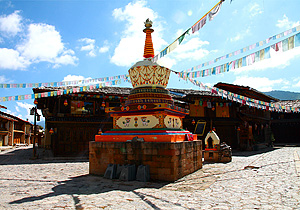Shangri-La Old Town (Dukezong)

Shangri-La mainly consists of two areas split by a street: Dukezong old town to the south and a new modern area to the north. Since the new area is mushrooming with expanding roads and characterless concrete buildings as other China developing cities, the white-wall old town is always the tourists focus to experience the real Tibetan feeling in its old Tibetan-style dwellings and the old Tibetan temples dotted with prayer flags and Buddhist sutras. Dukezong has a 1300-year history full of being burned down in the wars' flames and thriving as frontier trade to India and Lhasa. The present version we see today dates from Ming and Qing Dynasties.
Square Street, at the heart center of the old town, is the main tour area gathering a maze of cobbled lanes, white stupas, renovated tourist shops, café, bars, etc. Further away from the square street, the narrow winding lanes will give you a quieter shelter and unveil you more authentic local touch with the unrestored structures and real local life. The main town square is a snack and bauble market during daytime and a lively dancing place for Tibetan locals at night. Anyone interested in can freely join in. Scripture Chamber, a temple renovated from a memorial for the Red Army in 1936 can be viewed nearby the square. Guishan Park nearby has a temple with a giant bronze prayer wheel and an overview of the town area. Another smaller monastery at the south of the town offers an overlooking view of the old town.
The two-storey wooden house on Beimen Street, owned by an old man named Apur, is also worthy a visit to trace part of the town history in its ancient dynasty carvings, old time bandit marks, as well as late 20 century red revolution slogan paints the commune work point record.